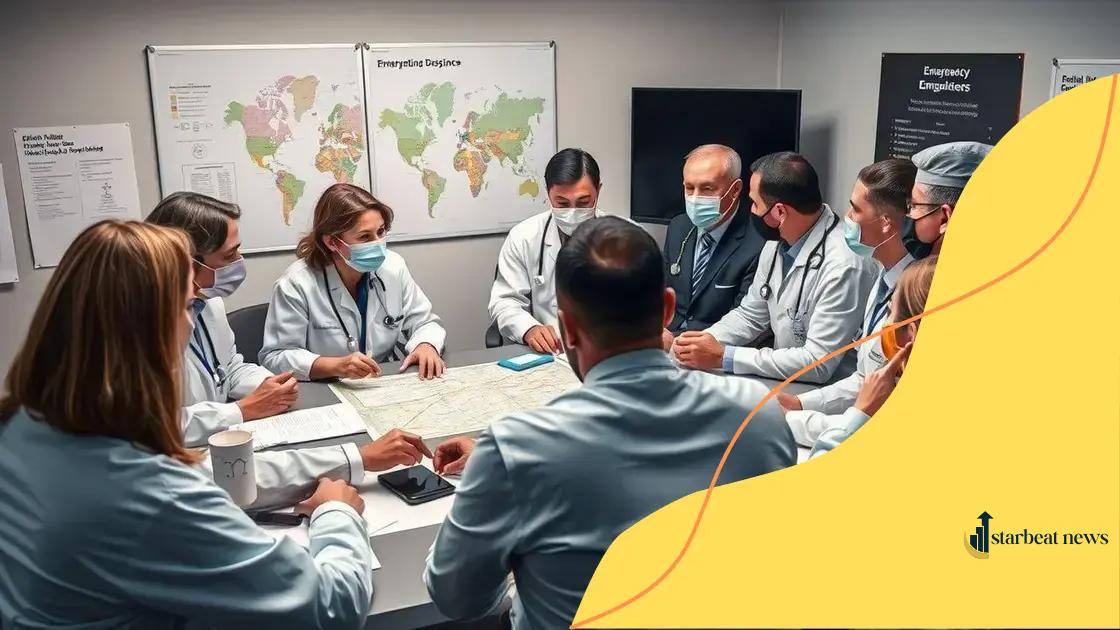Public health emergencies: understanding their impact

Anúncios
Public health emergencies are critical situations that threaten community health and require immediate responses, utilizing technology for detection, communication, and coordination to effectively manage outbreaks and crises.
Public health emergencies are critical situations that can endanger the well-being of communities worldwide. Have you ever wondered how they affect our daily lives? Join us as we explore their implications and the importance of timely responses.
Anúncios
Defining public health emergencies
Understanding public health emergencies is crucial for everyone. These situations can arise suddenly and affect large groups of people. Often linked to disease outbreaks, natural disasters, or bioterrorism, they require swift action and collaboration among various sectors.
Key Characteristics
Public health emergencies share some common characteristics. They lead to:
- Immediate threats to health and safety.
- High levels of public anxiety and confusion.
- Significant impacts on health resources and infrastructure.
In many instances, local and national health agencies must respond quickly. They coordinate with first responders, healthcare facilities, and community organizations to address the situation. The need for clear communication is vital, as misinformation can spread rapidly.
Anúncios
Common Types of Emergencies
Various scenarios can trigger a public health emergency. Some common types include:
- Outbreaks of infectious diseases.
- Natural disasters, such as hurricanes or earthquakes.
- Foodborne illness outbreaks.
- Environmental hazards, like chemical spills.
Each type requires a tailored response plan. Understanding the nature of these emergencies helps communities prepare better and respond effectively.
Historical examples of public health crises
Throughout history, there have been significant public health crises that shaped how societies respond to health threats. These events often reveal the vulnerabilities in public health systems and highlight the need for proactive measures.
The 1918 influenza pandemic
The 1918 influenza pandemic, also known as the Spanish flu, is one of the deadliest pandemics in history. It infected about one-third of the world’s population and caused millions of deaths globally. During this time, public health officials implemented measures such as quarantine, mask mandates, and social distancing to control the spread.
HIV/AIDS epidemic
The emergence of HIV/AIDS in the late 20th century marked another critical public health emergency. Initially misunderstood, it led to widespread fear and stigma. Governments and organizations developed extensive awareness campaigns and treatments that transformed HIV from a fatal disease to a manageable condition.
COVID-19 pandemic
Recently, the COVID-19 pandemic dramatically affected lives, economies, and health systems worldwide. As countries implemented lockdowns and vaccination drives, the importance of global cooperation became evident. This crisis emphasized the need for rapid data sharing and effective communication to combat misinformation.
Lessons learned
Each of these examples provides valuable lessons. They remind us of the importance of preparedness, research, and community engagement. Improved public health infrastructure and rapid response teams are essential for managing future crises effectively.
Key responses to health emergencies

Responding effectively to health emergencies is critical for minimizing their impact. Different situations require tailored approaches, but there are some key strategies that are often employed.
Rapid assessment and mobilization
When a health emergency occurs, the first step is to assess the situation quickly. This includes gathering data on the outbreak or crisis and mobilizing resources efficiently. Public health officials work with hospitals, government agencies, and NGOs to ensure a coordinated response.
Public communication
Clear communication plays a vital role during health emergencies. Keeping the public informed helps to reduce panic and misinformation. Health departments use various channels, such as social media, press releases, and public service announcements, to share information about the crisis.
Collaboration across sectors
A successful response often involves collaboration among multiple sectors. This includes:
- Healthcare providers who manage patient care.
- Local governments coordinating community support.
- Emergency services that provide rapid response.
- International organizations that offer expertise and resources.
Working together enhances the ability to respond effectively and share resources.
Another critical component is the implementation of prevention strategies. Vaccination campaigns and health education programs are essential in controlling outbreaks and educating the public on best practices. In addition, developing emergency response plans before crises occur can dramatically improve outcomes.
The role of technology in managing health crises
Technology plays a crucial role in managing health crises. From early detection to effective communication, innovations in healthcare can greatly improve responses to emergencies.
Early detection and surveillance
Modern technology allows for advanced surveillance systems that track disease outbreaks. Real-time data collection from various sources helps health officials identify problems quickly. This can include:
- Wearable health devices that monitor vital signs.
- Mobile apps that report symptoms.
- Data analytics software that predicts trends.
Such tools enhance the ability to respond to emerging threats proactively.
Telemedicine innovations
During crises like pandemics, telemedicine has become vital. With the help of video calls and online consultations, healthcare providers can reach patients without physical contact. This approach protects both patients and medical staff. Moreover, telemedicine is convenient for individuals with mobility issues or those living in remote areas.
Communication and information dissemination
Technology enables rapid communication during emergencies. Social media platforms, health organization websites, and mobile alerts provide vital information to the public. This ensures people receive timely updates about safety measures and treatment options.
Additionally, data visualizations—like interactive maps showing outbreak spread—help people understand the situation better. When the public is well-informed, they can make safer choices.
Furthermore, collaboration tools among health professionals improve teamwork. Technologies such as shared digital platforms allow healthcare and emergency management teams to coordinate better and respond more swiftly.
Future challenges in public health emergencies
As we look ahead, the landscape of public health emergencies is changing rapidly. Understanding the future challenges is essential for effective preparation and response.
Emerging infectious diseases
New infectious diseases continue to appear. As the world becomes more interconnected, pathogens spread more easily across borders. This makes monitoring and controlling outbreaks a top priority. The rise of antibiotic-resistant bacteria adds another layer of complexity.
Globalization and urbanization
Rapid globalization and urbanization can also strain public health systems. As more people move to cities, the risk of overcrowding and increased disease transmission grows. Urban environments may struggle to provide adequate healthcare resources, especially during emergencies.
Climate change impacts
Climate change is another significant factor. Changes in weather patterns can affect disease vectors, such as mosquitoes that carry viruses like Zika and dengue. This means areas previously unaffected by certain diseases may suddenly become at risk. Public health systems must adapt and prepare for these shifts.
Technological advancements
While technology plays a vital role in managing health crises, it also brings challenges. Privacy concerns arise with the increasing use of data collection and tracking. Additionally, ensuring equitable access to technology is crucial, as not everyone has the same resources.
Funding and resources
Finally, funding and resource allocation remain pressing issues. Public health systems often face budget cuts. Ensuring that adequate funds are available to build robust systems and respond to crises is vital for success.
FAQ – Frequently Asked Questions about Public Health Emergencies
What are public health emergencies?
Public health emergencies are situations that threaten the health and safety of a community, requiring urgent response and coordination.
How can technology help during health crises?
Technology facilitates early detection, enhances communication, and supports the coordination of resources among health agencies.
What role does public awareness play in health emergencies?
Public awareness is crucial for informing communities about safety measures, reducing panic, and ensuring compliance with health guidelines.
What challenges do we face in future health emergencies?
Future challenges include emerging infectious diseases, climate change impacts, and the need for sustainable funding for public health initiatives.